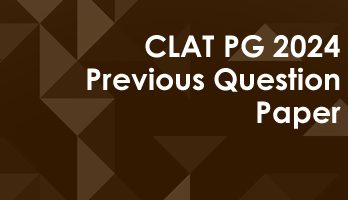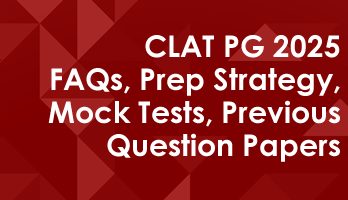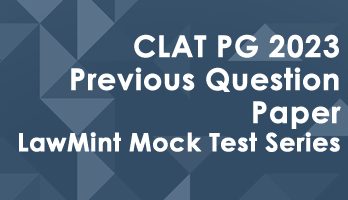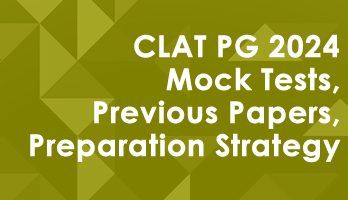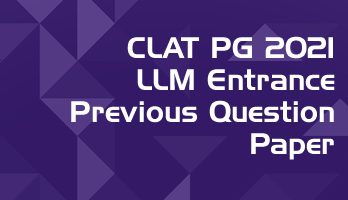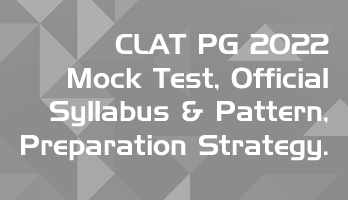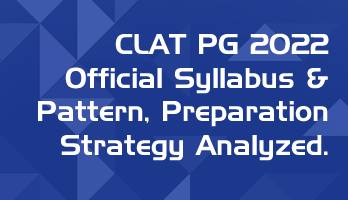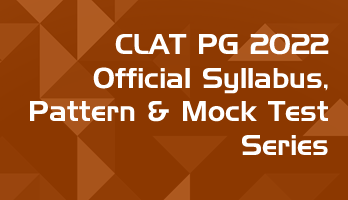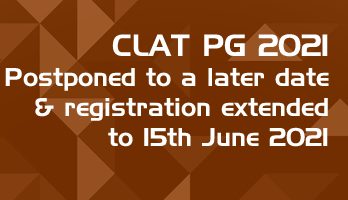This series of articles contains the complete CLAT PG 2020 question paper, conducted for the LLM admissions through the CLAT 2020 exam. In 2020, the pattern of the question paper was changed from the traditional MCQs to a ‘Comprehension based’ model. Each article in this series has one passage and the ten questions following it.
This article contains Passage 6 and the associated questions. The video embedded below discusses the answers as per the official key and the approach that can be used for such questions.
The answers to all the questions, for all the passages in the CLAT PG question paper are discussed in our YouTube video series at : https://www.youtube.com/lawmint
To make use of this question paper :
(1) The links to the complete series of articles is given below
(2) Read the passages and questions that follow
(3) Open our YouTube channel in another window or on your mobile phone (The video covering this specific passage is also embedded below.)
(4) Go through the series of videos where the answers to all the questions are discussed
The original plan by the CLAT Consortium was to have 10 passages, with 10 questions per passage and a subjective part. However, the subjective part was dropped and the number of passages was increased.
The CLAT PG 2020 exam had 12 passages, 120 questions – to be answered in 120 minutes. Click on the links below for the individual passages and the questions associated with the passage.
- Updated as per latest CLAT PG pattern
- Overall there are 300+ comprehension passages - with 2350+ questions
- 100 passages are provided as stand-alone mini mock tests
- 120 passages are combined to form 10 full-length mock tests
- 2020, 2021, 2022, 2023 and 2024 (New Pattern) Question papers included as mock tests
- Answers include the reason or 'rationale' for better understanding
- Order of the questions and answer choices are shuffled in every attempt for better practice
- The passages are of various lengths and complexities for better practice
- Unlimited access & practice - valid for one year from date of purchase
- Accessible 24 x 7 via Smart-Phone browsers and Desktops
- More the 100 LawMint users were selected by various top NLUs in 2020, 2021, 2022 and 2023 - Including NLSIU, NALSAR, NLU-J, WBNUJS
- Our users were also selected for the IIT KGP LLM, NLU Delhi (AILET PG) & DU LLM programs
Also included in the pack : (Useful for non-CLAT LLM entrance exams) :
- 11 CLAT PG old pattern previous Papers - 2009 to 2019 (as mock tests)
- 50 full-length old MCQ format mock tests (100 questions each)
- 50 old pattern MCQ mini-mock tests (25 questions each)
- Summarized overview of Important Jurisprudence topics (For Subjective & Objective questions)
- Overview of all Constitutional Amendments
- All Tests & Previous Papers are timed and have Negative marking for realistic simulation
- Questions & Answer Choices randomly shuffled in every attempt for better practice
Authentic Feedback from previous LawMint users :
I got AIR 21 in CLAT PG. Thank you so much. Your mocks helped me a lot in my preparation 🙂 - Ayushi Jain
I have subscribed to your CLAT PG program and got AIR 36 in this year CLAT PG. I have also secured AIR 54 in AILET PG exam. I would like to thank you. Your mock paper really helps a lot - Shrashank Tripathi
I would like to thank you for the CLAT PG LLM COURSE. Practising mock tests there helped me in getting confidence and hence I was able to get AIR 45 in CLAT PG LLM - Akshay Awasthi
A year back, I relied on the IIT Kharagpur RGSOIPL mock test series by LawMint to prepare for my RGSOIPL entrance test. Few months back, I relied on your UGC NET Law series to prepare for UGC NET. I was the topper of the RGSOIPL entrance, and have cracked JRF in UGC NET. All thanks to LawMint - Anshuman Sahoo
"I got AIR 18 in CLAT PG and General Category rank 28 in AILET PG. I want to thank you for helping me practice well in controlled conditions from any place. It gave me a lot of confidence and I took the tests while travelling too. I also made it to IIT Kharagpur." - Vinodharani
"Lawmint has been of great help to me in securing AIR 25 in AILET PG and AIR 29 in CLAT PG examinations. The subjective and objective approach of the test series kept me up to date with the latest exam pattern." - Bhawna Nanda
"I, Nimmy Saira Zachariah joined you clat test series. I cleared AILET PG with 30th rank. Your test series were of immense help as it gave me clear idea of where my preparations stand thank you once again law mint." - Nimmy S Z
"Hey guys. Where do I start? If I thought that getting AIR 59 in Clat PG was it, then how wrong I was. With Lawmint now I have cracked UGC NET as well." - Joyanta Chakraborty
- CLAT PG 2020 – Comprehension Passage 1
- CLAT PG 2020 – Comprehension Passage 2
- CLAT PG 2020 – Comprehension Passage 3
- CLAT PG 2020 – Comprehension Passage 4
- CLAT PG 2020 – Comprehension Passage 5
- CLAT PG 2020 – Comprehension Passage 6
- CLAT PG 2020 – Comprehension Passage 7
- CLAT PG 2020 – Comprehension Passage 8
- CLAT PG 2020 – Comprehension Passage 9
- CLAT PG 2020 – Comprehension Passage 10
- CLAT PG 2020 – Comprehension Passage 11
- CLAT PG 2020 – Comprehension Passage 12
CLAT PG Comprehension Passage 6
Read the piece written by Prof. Upendra Baxi and answer the questions below:
No matter how the matters are for the time being resolved (and swiftly on all indications), the present crisis in the Supreme Court involves mainly a contention on how judicial business should be conducted. The extraordinary movement of four justices in making public a letter addressed to the Chief Justice of India (CJI) in November 2017, and assorted observations at the press conference last week are very unusual judicial happenings.
At that conference, Justice Chelameswar said that “less than desirable things have happened” and the protesting Justices vainly “tried to collectively persuade” the CJI to take “remedial measures”. These happenings are now made even more unusual by Justice Ranjan Gogoi reportedly denying any “crisis” and Justice Kurian Joseph saying the matter is now settled leaving little scope for “outside intervention”. However, the letter released at the press conference said otherwise; it spoke of the ways in which “the overall functioning of the justice delivery system”, the “independence of the high courts”, and the functioning of the office of the CJI have been “adversely affected”. A moving appeal to the Indian “Nation” was issued at the press conference and Justice Chelameswar justified speaking out, lest “wise people” say later that they were complicit.
A situation where four senior-most justices went public to express their discontent with the present CJI’s exercise of authority to constitute Benches raises grave constitutional questions. Although only an in-house rectification can save matters, it is an anti-democratic error of grave proportions to think that co-citizens should have no interest, stake, or say in the matter. Undoubtedly, the Chief Justices, whether of the High courts or the Supreme Court, have the power to order the roster. The question is whether that power is coupled with a constitutional duty to follow certain conventions. Obviously, there are a few: Chief Justices have a primary duty of accountability to the Brother Justices, the Bar, and a general obligation through the Bar to the litigating public and people at large. But when a letter by four Senior Justices has been ignored for about two months, is going public with a copy of that letter and holding even a press conference unjudicial?
On this question opinions are varied. Some have lauded this step as heroic while others regard this as “sheer trade union tactics” and some even say the step was extremely unfortunate but now some institutional solidarity should pave the path ahead. What are the other conventions? First, a part-heard matter may not be divested from the co-justices who are seized with it. Second, the CJI may not deny a request for recusal on grounds of conflict of interest. Third, the Chief Justice may not ignore the requests by co-justices to form a larger Bench. Fourth, a Chief Justice may not selectively assign sensitive or important cases to the same judges. However, fifth, it is doubtful whether there is, or ought to be, a convention requiring such matters to be heard only by the senior-most justices. No, because the decision to elevate a citizen to judgeship must involve all relevant considerations; once elevated, a justice is co-equal to all other brethren. Sixth, it is true that co-equality occurs within a hierarchy: Not every justice becomes a Chief Justice, and the SC collegium must comprise the five senior-most justices. Outside this framework, the question about the rank-ordering may not arise; all Justices speak for the constitutional court. Any discussion about benches headed by —junior” justices is therefore injudicious.
The second issue looming large is the finalisation of Memorandum of Procedure (MoP). In early July 2017 (in Justice Karnan’s case), at least two Justices observed a need “to revisit the process of appointment of judges and establishment of a mechanism for corrective measures other than impeachment”. The letter also suggests that the issue of MoP “cannot linger on for indefinite period” and since the government has not responded to the MoP sent as far back as March 2017, the Court must now presume this long “silence” amounts to acceptance. Convening a full court and/or an agreement of the Chief Justices’ conference stand was suggested. The highest court in the land cannot endlessly wait for the government.
The remedies of impeachment and removal for judicial misconduct and review, and now curative jurisdiction, constitutionally exist. And further, the spectre of the call of conscience to go to the “Nation” will now haunt all Chief Justices. Informed criticism has some impact on judicial dispositions. But the ultimate guarantee of fairness as justice lie with the Justices themselves. As Eugene Ehrlich, a founder of European sociology of law, said: “The best guarantee of justice lies in the personality of the judge.” Justices must be seen practising what they preach to the other holders of public power. It is only when they collectively fail to do so that a democracy is truly imperilled.
51. Consider the following statements:
1. CJI is the boss of High Court Judges
2. CJI is superior to other Judges of the Supreme Court
3. CJI and other four members of Collegium for appointment of Judges in Supreme Court are equal
4. Chief Justice is one amongst equals and vested with many administrative powers.
Which of the statement given above is / are correct?
a) 1 and 3 only
b) 2 and 3 only
c) 3 only
d) 1, 2, and 4 only
52. Consider the following statements:
1. A Bench of the Supreme Court must follow a decision delivered by a Bench of a larger or even equal strength.
2. In case of inability to agree, the only option available is to refer the matter to the CJI, requesting that a larger Bench be constituted to resolve the conflict.
3. This basic principle was laid down by Supreme Court in Central Board of Dawoodi Bohra Community vs State Of Maharashtra & Anr (December 17, 2004).
Which of the statement given above is / are correct?
a) 1 and 3 only
b) 1 and 2 only
c) 3 only
d) 1, 2 and 3
53. Consider the following statements:
1. The Constitution does not make CJI the “Master of Roster”
2. The Supreme Court Rules vests in CJI the power of the “Master of Roster”
3. The Constitution of India read with Supreme Court Rules vests in CJI the Power of the “Master of Rolls”
4. The Power is neither given by the Constitution not by the Supreme Court Rules. It’s just a convention.
Which of the statement given above is / are correct?
a) 1 and 3 only
b) 2 only
c) 3 and 4 only
d) 1, 3 only
54. Consider the following statements:
1) A judge of Supreme Court can be removed from his office by the Parliament.
2) A judge of Supreme Court can be impeached from his office by the President on the recommendation of Chief Justice of India.
3) The removal of Supreme Court judge is based on two grounds – proved misbehaviour or incapacity to act.
Which of the statement given above is / are correct?
a) 1 and 2 only
b) 2 and 3 only
c) 3 only
d) 1, 2 and 3
55. Accountability makes the exercise of power more efficient and effective. The ancient Greek historian Herodotus said: “The Greeks though free [were] not absolutely free; they [had] a master called the law.” Which of the following statement correctly describes the law?
a) CJI as Master of Rolls is not bound by any law.
b) CJI is bound by the conventions mentioned in the passage above.
c) CJI in his administrative capacity is bound by law.
d) CJI as Master of Roster must act fairly, justly and in non-arbitrary manner.
56. Supreme Court Rules framed under Article 145 of the Constitution provide CJI as the Master of Rolls. These rules-
a) Cannot be challenged as per Justice Dinakaran Judgment
b) Can be challenged before the President of India who is the appointing authority of CJI and other Judges
c) Rules made by the Court violative of Fundamental Rights may be struck down as ultra vires the Constitution as per Prem Chand Garg (1963) judgment of the Supreme Court.
d) Supreme Court is supreme and no authority can question it.
57. In S. P. Gupta v. Union of India, it was held that the word ‘Consultation’ means:
a) Discussion
b) Ascertainment of opinion
c) Concurrence
d) Advice
58. Per Incuriam means:
a) Judgment given against law
b) Judgment given contrary to people’s conscience
c) Judgment given contrary to natural law
d) All of the above
59. In which of the following cases, Supreme Court held that “Chief Justice is an institution himself’?
a) Kamini Jaiswal v. Union of India
b) Asok Pande v. Union of India
c) S.P. Gupta v. Union of India
d) Prashant Bhushan v. Union of India
60. In which of the following cases, Chief Justice was held to be as ‘Master of Roster’, who alone has prerogative to constitute bench?
a) Prakash Chandra v. Union of India (UOI) through Secretary to the Government of India
b) S P Gupta v. Union of India
c) Third Judges Case
d) Justice C. S. Karnan v. The Hon’ble Supreme Court of India
- Updated as per latest CLAT PG pattern
- Overall there are 300+ comprehension passages - with 2350+ questions
- 100 passages are provided as stand-alone mini mock tests
- 120 passages are combined to form 10 full-length mock tests
- 2020, 2021, 2022, 2023 and 2024 (New Pattern) Question papers included as mock tests
- Answers include the reason or 'rationale' for better understanding
- Order of the questions and answer choices are shuffled in every attempt for better practice
- The passages are of various lengths and complexities for better practice
- Unlimited access & practice - valid for one year from date of purchase
- Accessible 24 x 7 via Smart-Phone browsers and Desktops
- More the 100 LawMint users were selected by various top NLUs in 2020, 2021, 2022 and 2023 - Including NLSIU, NALSAR, NLU-J, WBNUJS
- Our users were also selected for the IIT KGP LLM, NLU Delhi (AILET PG) & DU LLM programs
Also included in the pack : (Useful for non-CLAT LLM entrance exams) :
- 11 CLAT PG old pattern previous Papers - 2009 to 2019 (as mock tests)
- 50 full-length old MCQ format mock tests (100 questions each)
- 50 old pattern MCQ mini-mock tests (25 questions each)
- Summarized overview of Important Jurisprudence topics (For Subjective & Objective questions)
- Overview of all Constitutional Amendments
- All Tests & Previous Papers are timed and have Negative marking for realistic simulation
- Questions & Answer Choices randomly shuffled in every attempt for better practice
Authentic Feedback from previous LawMint users :
I got AIR 21 in CLAT PG. Thank you so much. Your mocks helped me a lot in my preparation 🙂 - Ayushi Jain
I have subscribed to your CLAT PG program and got AIR 36 in this year CLAT PG. I have also secured AIR 54 in AILET PG exam. I would like to thank you. Your mock paper really helps a lot - Shrashank Tripathi
I would like to thank you for the CLAT PG LLM COURSE. Practising mock tests there helped me in getting confidence and hence I was able to get AIR 45 in CLAT PG LLM - Akshay Awasthi
A year back, I relied on the IIT Kharagpur RGSOIPL mock test series by LawMint to prepare for my RGSOIPL entrance test. Few months back, I relied on your UGC NET Law series to prepare for UGC NET. I was the topper of the RGSOIPL entrance, and have cracked JRF in UGC NET. All thanks to LawMint - Anshuman Sahoo
"I got AIR 18 in CLAT PG and General Category rank 28 in AILET PG. I want to thank you for helping me practice well in controlled conditions from any place. It gave me a lot of confidence and I took the tests while travelling too. I also made it to IIT Kharagpur." - Vinodharani
"Lawmint has been of great help to me in securing AIR 25 in AILET PG and AIR 29 in CLAT PG examinations. The subjective and objective approach of the test series kept me up to date with the latest exam pattern." - Bhawna Nanda
"I, Nimmy Saira Zachariah joined you clat test series. I cleared AILET PG with 30th rank. Your test series were of immense help as it gave me clear idea of where my preparations stand thank you once again law mint." - Nimmy S Z
"Hey guys. Where do I start? If I thought that getting AIR 59 in Clat PG was it, then how wrong I was. With Lawmint now I have cracked UGC NET as well." - Joyanta Chakraborty


